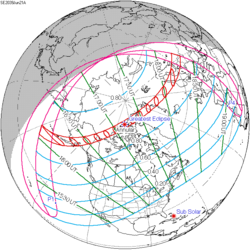| Annular eclipse | |
| Gamma | 0.7455 |
|---|---|
| Magnitude | 0.9464 |
| Maximum eclipse | |
| Duration | 263 s (4 min 23 s) |
| Coordinates | 71°30′N176°12′W / 71.5°N 176.2°W |
| Max. width of band | 298 km (185 mi) |
| Times (UTC) | |
| Greatest eclipse | 23:40:15 |
| References | |
| Saros | 147 (25 of 80) |
| Catalog # (SE5000) | 9635 |
An annular solar eclipse will occur at the Moon's ascending node of orbit between Sunday, July 1 and Monday, July 2, 2057, [1] with a magnitude of 0.9464. A solar eclipse occurs when the Moon passes between Earth and the Sun, thereby totally or partly obscuring the image of the Sun for a viewer on Earth. An annular solar eclipse occurs when the Moon's apparent diameter is smaller than the Sun's, blocking most of the Sun's light and causing the Sun to look like an annulus (ring). An annular eclipse appears as a partial eclipse over a region of the Earth thousands of kilometres wide. Occurring about 1.7 days after apogee (on June 30, 2057, at 6:30 UTC), the Moon's apparent diameter will be smaller. [2]
Contents
- Eclipse details
- Eclipse season
- Related eclipses
- Eclipses in 2057
- Metonic
- Tzolkinex
- Half-Saros
- Tritos
- Solar Saros 147
- Inex
- Triad
- Solar eclipses of 2054–2058
- Saros 147
- Metonic series
- Tritos series
- Inex series
- References
- External links
The path of annularity will be visible from parts of northwest China, Mongolia, eastern Russia, northern Alaska, western and central Canada, and far northeast Minnesota, northern Michigan, and far western New York in the United States. A partial solar eclipse will also be visible for parts of East Asia, Northeast Asia, Northern Europe, and North America.






































































































